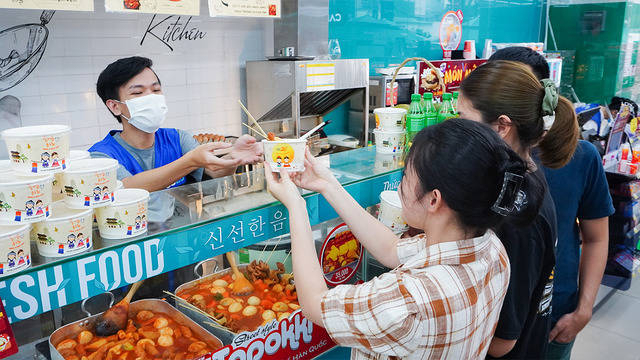SEOUL (ANN/THE KOREA HERALD) – Grappling with a saturated domestic market, South Korean convenience store giants are now setting their sights on international expansion, particularly across Southeast and Central Asia.
This strategic move comes amid burgeoning economic growth in these regions and a rising affinity for Korean culture, driving demand for Korean-style comprehensive convenience stores.
At present, the leading players in South Korea’s convenience store sector, BGF Retail and GS25, have established a formidable presence with a total of 1,168 outlets overseas.
GS25 leads with 573 stores bearing its brand in Vietnam and Mongolia, while BGF Retail operates 543 CU stores across Mongolia, Malaysia, and Kazakhstan.
Emart24, a smaller competitor under the Shinsegae Group, also contributes to the overseas footprint with 52 stores in Malaysia.
The companies are expanding their footprint in the Central Asian market, leveraging their expertise in managing compact stores equipped with centralised product distribution systems.
“Just as neighbourhood supermarkets in Korea were not seen as standard nationwide until around the 1980s, supermarkets in Central Asian countries weren’t modernised until the entry of Korean convenience stores,” said an official from one of the Korean operators, speaking on condition of anonymity.
“As these Central Asian countries achieve economic growth, there is a growing demand for sophisticated and standardised convenience stores where consumers can enjoy consistent product quality no matter where they are.”
The very beginning of the convenience store industry in Korea was not as sophisticated as it is today.

Only after the first three domestic convenience stores owned by Lotte Group – which opened in the early 1980s – all closed in 1984, did the first 7-Eleven store appear in Seoul in 1989, spreading convenience stores across the nation.
Since then, homegrown brands began to emerge, primarily focusing on benchmarking Japanese-style neat and modern convenience stores.
“The initial perception of convenience stores among Koreans was not positive due to their higher prices for the sake of ‘convenience.’ However, they experienced rapid growth during the economic crisis in the late 1990s and early 2000s, as ready-made meals such as lunch boxes and instant cup noodles became popular for their affordability,” said Chang Woo-cheol, a professor of tourism and hospitality industry at Kwangwoon University.
“The increase in one-person households and the development of new towns in Korea also fueled the demand for convenience stores. In particular, conglomerate-led centralised logistics systems contributed to the modernised convenience stores we see today,” he added.
In the meantime, industry officials said that the nation’s convenience store industry boom came with various merchandising efforts from domestic companies in recent years.
“Not only Korean customers but also foreign visitors love visiting convenience stores in Korea due to their diverse and unique product offerings,” a BGF Retail official said. “For instance, we release numerous collaboration products in partnership with various conglomerates, with over 1,000 new products launched annually, even including gold bars, cars and massage chairs that you wouldn’t typically associate with convenience stores.”
The BGF Retail official also highlights the growing popularity of Korean culture as one of the key factors in their success both domestically and overseas.
“As Korean convenience stores are frequently featured in the media, the demand for Korean-style convenience stores in other countries has also increased. Reflecting this demand, shelves in our stores in Mongolia and Kazakhstan have price tags and product descriptions written in both the local language and Korean.”
Meanwhile, the focus on overseas expansion by Korean convenience stores comes amid the saturation of the market at home.
With BGF Retail and GS25 operating 18,000 and 17,390 stores, respectively, there are about 55,580 convenience stores in Korea. The figure is a significant increase from 38,451 in 2018, but the growth rate began to slow down starting in 2021 after years of excessive competition and growing operating losses.
Over the same period, the number of overseas BGF Retail and GS25 stores started to jump, reaching 209 and 191 in 2021, and 510 and 498 in 2023, respectively. They first entered overseas markets in 2018 with 21 and 26 stores, respectively.


